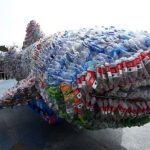Hosepipes inside a sperm whale, plastic banana bags eaten by green turtles and a shotgun cartridge inside a True’s beaked whale.
Just some of the examples of plastic found inside wildlife that have been documented in scientific reports.
Researchers went through records of plastic eaten by aquatic creatures to find out more about the risks.
They say the length of an animal can be used to estimate how big a piece of plastic it might accidentally consume.
They hope the data can be used to find out more about the risks. More than 700 species of marine and freshwater animals are known to ingest plastic, but study researcher Dr Ifan Jâms of Cardiff University said it was difficult to figure out how much plastic they could be eating.
“This information gives us a way to start measuring the extent of the plastic pollution problem,” he said. “We hope this study lays a foundation for including the ‘ingestibility’ of plastics into global risk assessments.”
Dr Jâms and colleagues at Cardiff trawled through published data to examine records of plastic found inside more than 2,000 marine and freshwater species, including mammals, reptiles, fish and invertebrates, from tiny fish larvae to 10-metre-long whales.
They created an equation to predict the maximum size of plastic item an animal can swallow, based on the length of its body.
The new equation could help determine the risk of plastics to any species – and the amount of plastic that may be moving into oceans and rivers, and entering food chains.
Project leader Prof Isabelle Durance said: “All of us will have seen distressing, often heart-breaking, images of animals affected by plastic, but a great many more interactions between animals and plastic are never witnessed. This study gives us a new way of visualising those many, many unseen events.”







